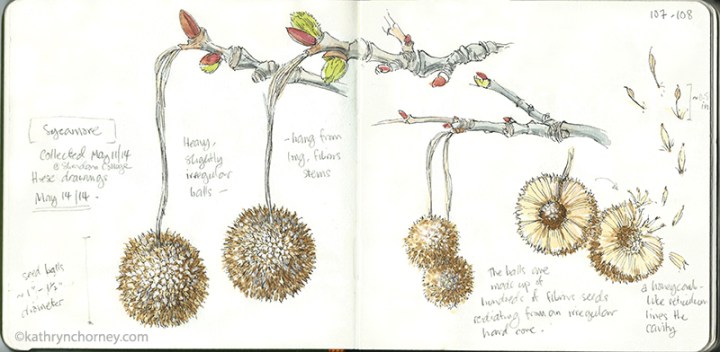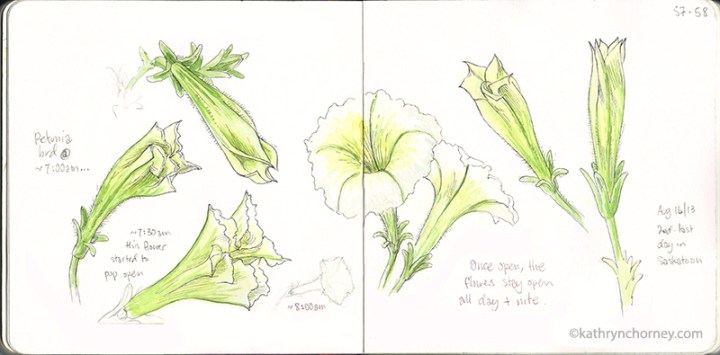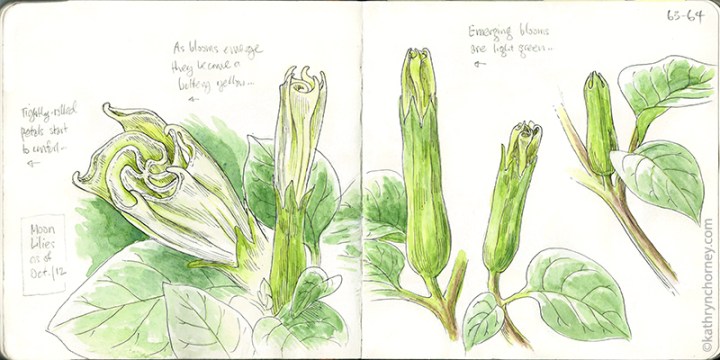Here are a baker’s-dozen selected favourites from my second nature journal, (2013-14), arranged in order of the seasons. These small ink-and-watercolour studies take only an hour or two. I use my small portable Winsor-Newton watercolour box with its single brush, and fine-tip ink pens. Keeping my eyes open, on the way to work, around the neighbourhood, anywhere in the city or out of town, there are always many things to learn, even really simple things, that are too easily overlooked. For example, did you know that the real name for a Pussy Willow is ‘Goat Willow’ (Salix caprea), and the soft furry ‘paws’ are actually the male flowers? Maybe you did! But I didn’t until I stopped to look and got inspired to find out.
Click on any image to launch full size slideshow. When finished, close slideshow by clicking on the x in the upper R corner. All images ©Kathryn Chorney.
- Highbush Cranberry, March. Because I’m left-handed, I have a habit of starting my notes at the right-hand side of the page and continuing towards the left. (I’m sure the only thing I can claim to have in common with Leonardo da Vinci.)
- Common Barberry, March. This branch was from a hedge at the end of my street, which is no longer there, having been torn out as part of a home-reno. It’s not a native plant, so it’s not a tragedy, but on the other hand it points out one of the important things about nature journalling — things are not permanent.
- Common Barberry, April. Portrait of Saturday Apr 27. The same hedge as previous sketch, now with new leaves and buds emerging. The return of colour is quite startling, after the greys of winter. Stems are brilliant, deep red. That fruit still remains at the end of a long winter, suggests that this fruit is not good food for our native bird and insect species.
- Goat Willow, Salix caprea. Mid-April — It is a sweet, sweet thing when Spring returns to Canada.
- Robins in Nest (May), and Magnolia Buds (April). I’ve mashed up two pages here — the robins sketch is from May ’13, and the Magnolia buds from Apr 27/13. These 4 young robins look impossibly packed into their tiny nest – but I swear the scale is accurate! The young birds fledged (left the nest) the following day.
- Jack in the Pulpit, near Guelph, Ontario, May 11. A spring ‘ephemeral’ — a type of plant that completes its entire growth and seed cycle early in the spring before the forest canopy closes in. You have to be out there to catch them at the right time, and we were lucky, on a spring hike with the Southern Ontario Nature and Science Illustrators group (SONSI).
- Sycamore, Sheridan College Campus, May
- Viburnum Opulus, the ‘Guelder Rose’
- White/Green Petunias, August. I drew these in my mother’s back garden early in the morning. Over the hour or so, one petunia blossom opened up – you can see the progression in the 3 sketches at lower left.
- Purple Petunias, August. More petunias in my mother’s garden. Me being me, I’m not primarily interested in pretty blooms (although they are lovely); I like to study the interesting forms of the emerging flowers as they unfold.
- Wild Clematis on the bank of the South Saskatchewan River, August. Another Right-to-Left sequence of the life stages of this plant.
- Wild Cucumber, August, blooming everywhere along the trails in our local park on the shore of Lake Ontario. Although it spreads in a profuse tangle, the plant has a very regular structure.
- Moon Lilies I, September. As a left-hander, I have a habit of starting drawings and notes on the right side of the page and continuing to the left. Look R-L to see the progression of this opening Moon Lily bud.
- Moon Lilies 2, October. As in the previous image, the progression in this drawing is from right to left (habit of a left-hander – I start my sketchbooks from the ‘back’ as well).














